
Thimphu
Thimphu is the most modern city in Bhutan with an abundance of restaurants, internet cafes, nightclubs and shopping centers, however it still retains its’ cultural identity and values amidst the signs of modernization.Thimphu is one of the few towns in Bhutan that have been equipped with ATM banking facilities and is a good place to stock up on some currency.
One of the most curious features of Thimphu is that it is the only capital city in the world that does not use traffic lights. Instead a few major intersections have policemen standing in elaborately decorated booths (small pavilions), directing traffic with exaggerated hand motions. The juxtaposition of ancient tradition and modernity make Thimphu the ideal location for visitors to break away from their tour itinerary and just immerse themselves in the lifestyle of contemporary Bhutanese.
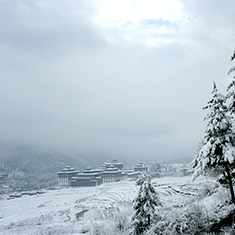
Trashichho Dzong
In 1641 Shabdrung Ngawang Namgyal took over that Dzong from the Lhapa Kagyu, reconsecrated, and renamed it Tashichö-dzong. It was then established as the main seat of the Southern Drukpa Kagyu and the summer residence of the monastic body or sangha headed by Shabdrung Rinpoche.
Most of this original dzong was destroyed by fire in 1772 and a new dzong was built at the present site by the sixteenth Desi, Sonam Lhudrup, and it was then consecrated by the thirteenth Je Khenpo, Je Yonten Taye, who named the new Dzong Sonamchö-dzong. Following the death of the Desi it was renamed Tashichö-dzong after the old Dzong.
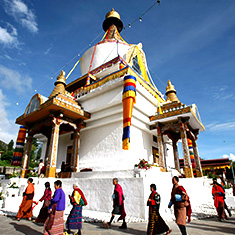
National Memorial Chorten
This stupa was built in the memory of Bhutan’s third King, His Late Majesty, King Jigme Dorji Wangchuk, who is popularly regarded as Father of modern Bhutan. The paintings and statues inside the monument provide a deep insight into Bhuddhist philosophy.
The chorten is a large white structure crowned with a golden spire. It is located close to the center of Thimphu city and is one of its most iconic monuments.
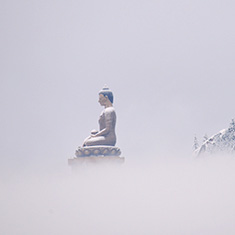
Buddha Dordenma
This massive statue of Shakyamuni measures in at a height of 51.5 meters, making it one of the largest statues of Buddha in the world. The statue is made of bronze and is gilded in gold. 125,000 smaller Buddha statues have been placed within the Buddha Dordenma statue, 100,000 8 inch tall and 25,000 12 inch tall statues respectively. Each of these thousands of Buddhas have also been cast in bronze and gilded. The throne that the Buddha Dordenma sits upon is a large meditation hall.
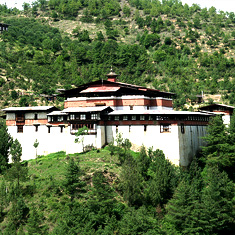
Simtokha Dzong
Five miles from Thimphu stands the 17th century Simtokha Dzong standing on a lofty ridge. Built in 1627, the oldest Dzong in the country, it now houses the School for Buddhist studies.
The name Simtokha literally means “Atop a Demon” and the legend associated with the dzong’s construction tells us that it was built in order to subdue an evil spirit that was harassing travelers in the region.
The dzong houses countless statues and paintings of various Buddhas, deities and religious figures including The Eight Manifestations of Guru Rimpoche, Jampelyang the Bodhisattava of Wisdom, Shakya Gyalpo the Buddha of Compassion and many more, all carved and painted in exquisite detail.
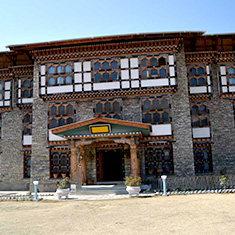
National Library
The National Library of Bhutan was first established in 1967 under the patronage of HM Queen Ashi Phuntso Choden (1911–2003), with a small collection of precious texts. The library was initially housed within the central tower (utse) of Tashichodzong. Later, due to its growing collection, it had to move to a building in the Changgangkha area of Thimphu.
To provide a permanent home for the sacred religious books and manuscripts in the growing collection, construction of the present four-storeyed eight-cornered traditional building, which looks like the central tower temple of a Bhutanese Dzong, in the Kawajangtsa area of Thimphu was initiated. The cost of the construction of this building was borne entirely by the Royal Government of Bhutan without any foreign aid.
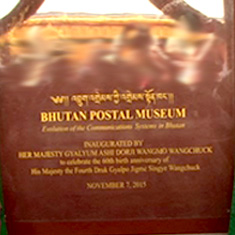
Bhutan Postal Museum
A recent addition to the museums in Thimphu, the postal museum is sure to be popular with philatelists. You can get an overview of the history of the postal system of Bhutan, beginning with the mail runners, who have exciting stories of their own, and view Bhutan’s supremely interesting and highly collectible stamps.Stamps were, incidentally, the first Bhutanese products that generated revenue for the government as it began its modernization efforts.
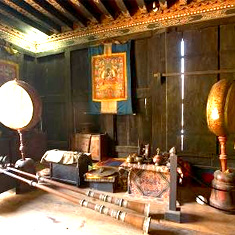
Folk Heritage Museum
Located in the capital city of Thimphu, this museum was established in 2001 and provides visitors and tourists with fascinating insights into the Bhutanese material culture and way of life. The Folk Heritage Museum is set inside a three storied, 19th century traditional house.
The museum gives you a glimpse of the traditional Bhutanese lifestyle, in addition to artifacts from rural households; it also displays an impressive collection of typical household objects, tools and equipment. The museum also organizes regular demonstrations of rural traditions, skills, habits and customs as well as hosting educational programs for children.
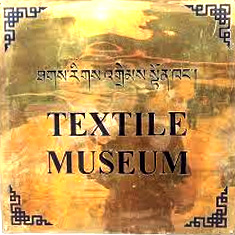
Royal Textile Academy
The Royal Textile Academy of Bhutan was founded to preserve and promote the living art of weaving which is an important part of the culture and tradition of Bhutan. Under the patronage of Her Majesty Ashi Sangay Choden Wangchuck, it is a non-government, non-profit organization established as an educational center for the training of individuals in traditional Bhutanese weaving.


